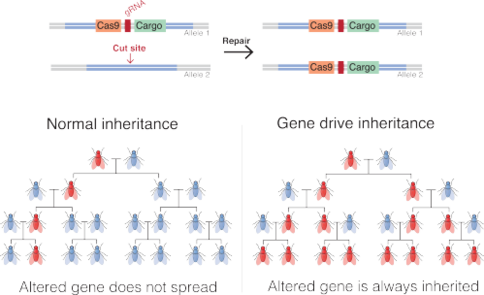
A gene drive is a natural process[1] and technology of genetic engineering that propagates a particular suite of genes throughout a population[2] by altering the probability that a specific allele will be transmitted to offspring (instead of the Mendelian 50% probability). Gene drives can arise through a variety of mechanisms.[3][4] They have been proposed to provide an effective means of genetically modifying specific populations and entire species.
The technique can employ adding, deleting, disrupting, or modifying genes.[5][6]
Proposed applications include exterminating insects that carry pathogens (notably mosquitoes that transmit malaria, dengue, and zika pathogens), controlling invasive species, or eliminating herbicide or pesticide resistance.[7][5][8][9]
As with any potentially powerful technique, gene drives can be misused in a variety of ways or induce unintended consequences. For example, a gene drive intended to affect only a local population might spread across an entire species. Gene drives that eradicate populations of invasive species in their non-native habitats may have consequences for the population of the species as a whole, even in its native habitat. Any accidental return of individuals of the species to its original habitats, through natural migration, environmental disruption (storms, floods, etc.), accidental human transportation, or purposeful relocation, could unintentionally drive the species to extinction if the relocated individuals carried harmful gene drives.[10]
Gene drives can be built from many naturally occurring selfish genetic elements that use a variety of molecular mechanisms.[3] These naturally occurring mechanisms induce similar segregation distortion in the wild, arising when alleles evolve molecular mechanisms that give them a transmission chance greater than the normal 50%.
Most gene drives have been developed in insects, notably mosquitoes, as a way to control insect-borne pathogens. Recent developments designed gene drives directly in viruses, notably herpesviruses. These viral gene drives can propagate a modification into the population of viruses, and aim to reduce the infectivity of the virus.[11][12]
- ^ Alphey, Luke S.; Crisanti, Andrea; Randazzo, Filippo (Fil); Akbari, Omar S. (2020-11-18). "Opinion: Standardizing the definition of gene drive". Proceedings of the National Academy of Sciences. 117 (49): 30864–30867. doi:10.1073/pnas.2020417117. ISSN 0027-8424. PMC 7733814. PMID 33208534.
- ^ Callaway E (21 July 2017). "US defence agencies grapple with gene drives". Nature. Retrieved 2018-04-24.
- ^ a b Champer J, Buchman A, Akbari OS (March 2016). "Cheating evolution: engineering gene drives to manipulate the fate of wild populations". Nature Reviews. Genetics. 17 (3): 146–59. doi:10.1038/nrg.2015.34. PMID 26875679.
- ^ Leftwich PT, Edgington MP, Harvey-Samuel T, Carabajal Paladino LZ, Norman VC, Alphey L (October 2018). "Recent advances in threshold-dependent gene drives for mosquitoes". Biochemical Society Transactions. 46 (5): 1203–1212. doi:10.1042/BST20180076. PMC 6195636. PMID 30190331.
- ^ a b Esvelt KM, Smidler AL, Catteruccia F, Church GM (July 2014). "Concerning RNA-guided gene drives for the alteration of wild populations". eLife. 3: e03401. doi:10.7554/eLife.03401. PMC 4117217. PMID 25035423.
- ^ Burt A (May 2003). "Site-specific selfish genes as tools for the control and genetic engineering of natural populations". Proceedings. Biological Sciences. 270 (1518): 921–8. doi:10.1098/rspb.2002.2319. PMC 1691325. PMID 12803906.
- ^ "U.S. researchers call for greater oversight of powerful genetic technology | Science/AAAS | News". News.sciencemag.org. 17 July 2014. Retrieved 2014-07-18.
- ^ Benedict M, D'Abbs P, Dobson S, Gottlieb M, Harrington L, Higgs S, et al. (April 2008). "Guidance for contained field trials of vector mosquitoes engineered to contain a gene drive system: recommendations of a scientific working group". Vector Borne and Zoonotic Diseases. 8 (2): 127–66. doi:10.1089/vbz.2007.0273. PMID 18452399.
- ^ Redford KH, Brooks TM, Macfarlane NB, Adams JS (2019). Genetic frontiers for conservation...technical assessment. doi:10.2305/iucn.ch.2019.05.en. ISBN 978-2-8317-1974-0. S2CID 212870281.
- ^ "This Gene-Editing Tech Might Be Too Dangerous To Unleash". Wired.
- ^ Walter, Marius; Verdin, Eric (2020-09-28). "Viral gene drive in herpesviruses". Nature Communications. 11 (1): 4884. Bibcode:2020NatCo..11.4884W. doi:10.1038/s41467-020-18678-0. ISSN 2041-1723. PMC 7522973. PMID 32985507.
- ^ "Gene Drives Could Kill Mosquitoes and Suppress Herpesvirus Infections". American Council on Science and Health. 2020-09-30. Retrieved 2020-10-07.